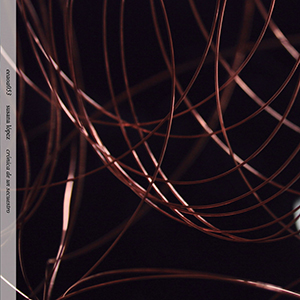Susana López, "Crónica de un Secuestro"
 In what will undoubtedly become a trend for artists in the coming months, Susana López’s latest work was conceived, constructed, and finalized during the lockdown. Largely completed early on, during the month of March, López took advantage of that forced isolation to produce this lengthy, rich disc of synthesizers, electronics, and processed voices. Although the sense of claustrophobia and tension are apparent, there is far more to Crónica de un Secuestro than just that.
In what will undoubtedly become a trend for artists in the coming months, Susana López’s latest work was conceived, constructed, and finalized during the lockdown. Largely completed early on, during the month of March, López took advantage of that forced isolation to produce this lengthy, rich disc of synthesizers, electronics, and processed voices. Although the sense of claustrophobia and tension are apparent, there is far more to Crónica de un Secuestro than just that.
There is an all-pervading sense of isolation throughout the disc, but not exclusively in that sense of being deprived of human contact.Instead it often feels more like being the proverbial stranger in a strange land:unfamiliar spaces and unknown experiences abound throughout.The bleak ambience throughout "Luz Negra" exemplifies this beautifully:a rhythmic loop and pulsating synth line are of course familiar touchstones when it comes to electronic music, but the way in which López layers and constructs them, as well as the buzzing electronics that appear later on, is anything but conventional.
The vintage tone to the sounds throughout "Thousand Drones to Nubla" conjures an unfamiliar sense of nostalgia that is foreign, but simultaneously inviting.Expansive ambient spaces and rhythmic thumps throughout are comforting in their own way.With a later addition of a guitar-like tone, she builds a wonderfully woozy mood throughout."Ibn Arabi" is constructed from a foundation of sustained drone that is expanded with continually falling electronics and the overt use of field recordings (which appear throughout the album as a whole, but never as explicitly as here.)
There are other moments in which the isolation has a more sinister, less inviting color to it, however.The buzzing sawtooth synth and drifting tones of the title piece make for a dense, swirling bit of heavy ambience.The density and rhythmic rattling cast the overall sound in a darker, bleaker mood.As perhaps the most stripped down composition here, "Huldra" is largely a roar of filtered and surging electronics with a distant, continuous heartbeat like throb adding a hint of creepiness.
It is on the album’s final piece, "The Last Wave," that López's work bares the most distinct trappings of quarantine and isolation.Falling just short of 20 minutes long, there are a multitude of intentionally sparse and repetitive passages that slowly expand.I would never say the piece is boring at any point, but López simulates that relentless sense of ennui that so many of us have been experiencing over the past six months.To this she adds infrequent, but undeniably forceful passages of deep and oppressive electronics that may break up the monotony, but also convey tension and dread beautifully.
I imagine there will be a lot of "quarantine" albums to be had this year, but Susana López's work does not seem as if it is forcing that theme in any way.The sparse structures and unconventional production feel isolating, but in almost an open, exploratory way.Other than the conclusion, Crónica de un Secuestro works more as the sound of an artist using her time forced indoors to create something unique and beautiful, but concluding on more of a downer note that really solidifies that, no matter how productively we try to use our time during all of this, fear and dread are never far behind.



